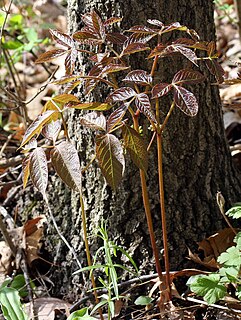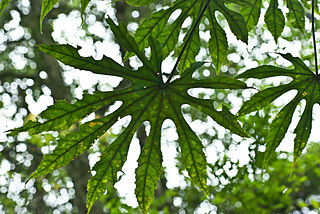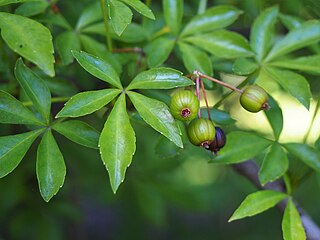
Aralia elata, the Japanese angelica tree, Chinese angelica-tree, or Korean angelica-tree, is a woody plant belonging to the family Araliaceae. It is known as tara-no-ki in Japanese, and dureup-namu (두릅나무) in Korean.

The Araliaceae are a family of flowering plants composed of about 43 genera and around 1500 species consisting of primarily woody plants and some herbaceous plants. The morphology of Araliaceae varies widely, but it is predominantly distinguishable based on its woody habit, tropical distribution, and the presence of simple umbels.

Aralia, or spikenard, is a genus of the family Araliaceae, consisting of 68 accepted species of deciduous or evergreen trees, shrubs, and rhizomatous herbaceous perennials. The genus is native to Asia and the Americas, with most species occurring in mountain woodlands. Aralia plants vary in size, with some herbaceous species only reaching 50 centimetres (20 in) tall, while some are trees growing to 20 metres (66 ft) tall.

Aralia spinosa, commonly known as devil's walking stick, is a woody species of plant in the genus Aralia, family Araliaceae, native to eastern North America. The various names refer to the viciously sharp, spiny stems, petioles, and even leaf midribs. It has also been known as Angelica-tree.

Zanthoxylum clava-herculis, the Hercules' club, Hercules-club, pepperwood, or southern prickly ash, is a spiny tree or shrub native to the southeastern United States. It grows to 10–17 m tall and has distinctive spined thick, corky lumps 2–3 cm long on the bark. The leaves are glabrous and leathery, pinnately compound, 20–30 cm long with 7-19 leaflets, each leaflet 4–5 cm long. The flowers are dioecious, in panicles up to 20 cm long, each flower small, 6–8 mm diameter, with 3-5 white petals. The fruit is a two-valved capsule 6 mm diameter with a rough surface, and containing several small black seeds. The tree has also been called Z. macrophyllum. The genus name is sometimes spelled Xanthoxylum.

Aralia cordata is an upright herbaceous perennial plant growing up to 2 to 3 metres in height, native to Japan, Korea and eastern China. Its common names include spikenard, herbal aralia, udo, Japanese spikenard, and mountain asparagus. It is commonly found on the slopes of wooded embankments. Aralia cordata is a species of Aralia in the family Araliaceae.

Aralia nudicaulis is a flowering plant of northern and eastern North America which reaches a height of 30–60 cm (12–24 in) with creeping underground stems.
Aralia dasyphylla is a species in the plant genus Aralia, family Araliaceae. Its native range is western Malesia. Some sources include Aralia dasyphylloides from southern China in this species.
Aralia hypoglauca is a species of flowering plant in the family Araliaceae. It has been treated as the only species Hunaniopanax hypoglaucus of the genus Hunanioglaucus.

Hume's short-toed lark is a species of lark in the family Alaudidae. It is found in south-central Asia from Iran and Kazakhstan to China.
Aralia elegans is a species of plant in the family Araliaceae. It is endemic to China.
Aralia javanica is a species of plant in the family Araliaceae. It is endemic to Indonesia.
Aralia malabarica is a species of plant in the family Araliaceae. It is endemic to India.

Fatsia polycarpa, the many-fruited aralia, is a species of flowering plant in the family Araliaceae, endemic to Taiwan, where it is threatened by habitat loss. Growing to 4 m (13 ft) tall by 2.5 m (8.2 ft) broad, it is a substantial evergreen shrub with large palmate leaves to 30 cm (12 in). Spherical clusters of cream or white flowers are produced in winter, followed by black fruits in spring.

Helicia is a genus of 110 species of trees and shrubs, constituting part of the plant family Proteaceae. They grow naturally in rainforests throughout tropical South and Southeast Asia, including India, Sri Lanka, Indochina, Peninsular Malaysia to New Guinea and as far south as New South Wales.
Aralia leschenaultii is a species of plant in the family Araliaceae. It is found in China, India, Myanmar, and Sri Lanka.
Triplophysa tibetana is a species of stone loach in the genus Triplophysa. It is endemic to the upper Brahmaputra and upper Indus rivers in Tibet. It lives in slower flowing, shallow areas in lakes and rivers with ample aquatic vegetation. It grows to 13.3 cm (5.2 in) SL.
A. japonica may refer to:
Aralia dasyphylloides is a species of flowering plant in the family Araliaceae, native to south China. Some sources have included it in Aralia dasyphylla.

Eleutherococcus sieboldianus, the five-fingered aralia or fiveleaf aralia, is a species of flowering plant in the family Araliaceae. It is native to Anhui province in China, and has been introduced to Korea, Japan and the United States. A variegated form is available which only reaches 8 ft (2.4 m).










